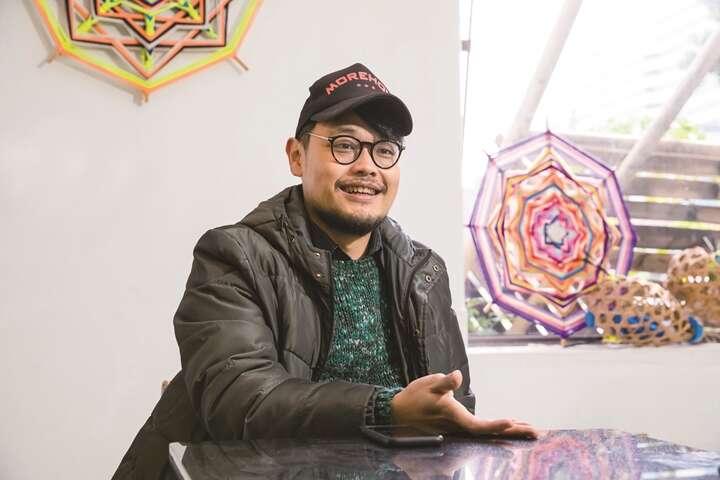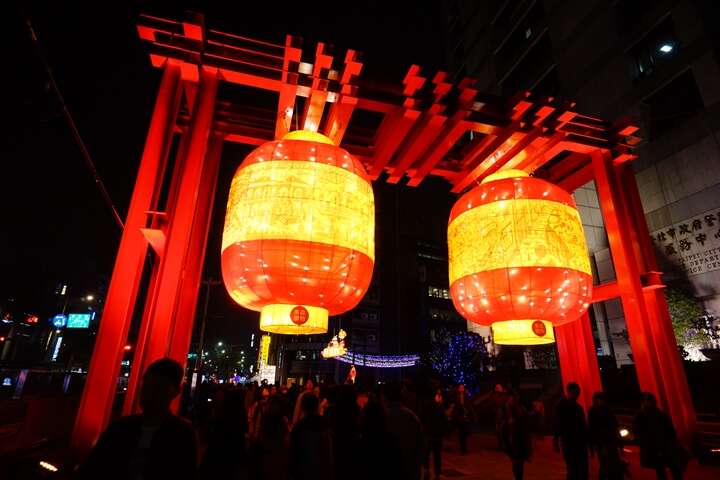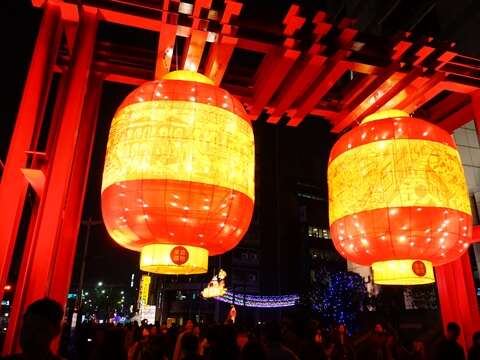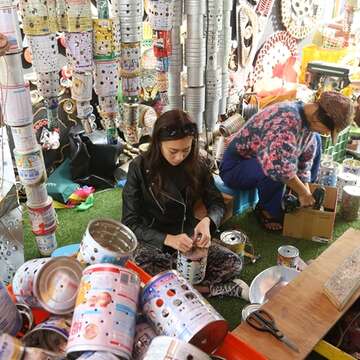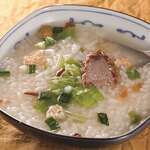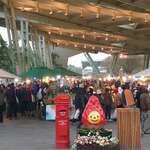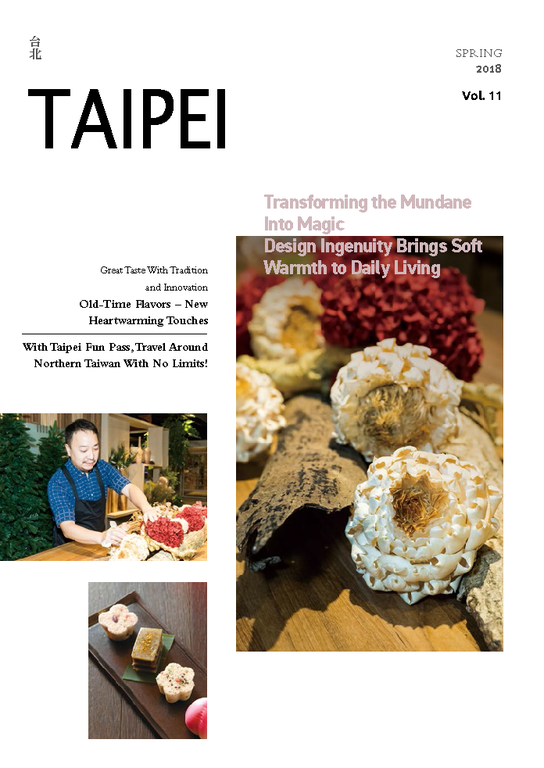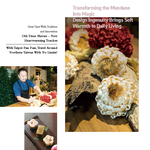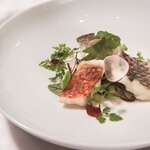Post date:2018-03-19
1345
A-Fu Uses Musician’s Sensation to Give Tradition a New Look
Add Creation to the Lantern Festival and Pass on Happiness
Article| Lin Xiuhan
Photos| Liu Deyuan, Gao Zansian
▲A-Fu brought together artists from many different fields to create a happy visual feast for the 2018 Taipei Lantern Festival. (Photo: Liu Deyuan)
After he announced Sodagreen’s (蘇打綠) intention to take a 3-year break, band leader A-Fu (阿福) continued to chase his dreams. In addition to attending various events, he also was appointed coordinator of the 2018 Taipei Lantern Festival and decided to break away from the old traditional patterns and change the way of presenting this celebration. He appealed to artists who care deeply about this land to come forward and help create a festival full of humanity, art and happiness.
Q1
You are a musician as well as the coordinator of the 2018 Taipei Lantern Festival. How did you connect these two roles?
I’m a musician, but I studied public administration at college, so I pay great attention to social issues as well. Musicians have many fans, therefore they wield a certain influence. I hope to use this power to change our society. In coordinating such a festival, it was my hope to achieve something other than just making music, such as convincing Taiwanese artists abroad to return to this land. This was the one thing I aspired to accomplish.
Q2
As a musician, what inspired you to throw yourself into the festival?
When I served in the army, I met performing artists from different disciplines, so I had the idea of organizing inter-disciplinary performances. We believe there are many beautiful things in Taipei, but most kids nowadays just stay home and watch TV or use their cell phones. So, starting in 2016 and 2017, we operated the Dusk Giant Wonderland (達斯克巨人樂園) on URS27 The Grand Green (華山大草原), which was just like an urban art gallery. It was an interactive amusement park combining art and music – by which we hoped to encourage children to enjoy the outdoors. Those giants were produced with the same materials used in building lanterns, so I brought the Wonderland experience to this year’s lantern festival. I also wanted this festival to allow people to see how young artists brought their talents to bear within the scope and beauty of a traditional festival.
Q3
What kinds of musical experiences did you draw on to bring the Taipei Lantern Festival to its next level?
As a musician, I like to add images and stories to everything. This is what I did for this project – giving every lantern a story, and not just presenting a representation of a dog or some other animal. I wanted the audience to experience the story and spirit behind each lantern, in order to bring the whole festival to a higher level.
Q4
As the art coordinator of the festival, what was the biggest challenge? And what were the breakthroughs and special features of this event?
The previous year’s Taipei Lantern Festival was a big success, which put us under a lot of pressure. But we took the mindset of “Let’s break the mold!” The size of the main lantern or the funds available were not the point. What we cared about was that people not only glanced at the lanterns but lingered and fully appreciated the message the artists were trying to express. At the end of the Chinese New Year holiday, people usually go look at the lanterns with their loved ones. So, we chose “Happy Go Go” as the theme of this year’s fest. There was also a lantern-building activity for attendees and their love ones to participate in.
Q5
What were the values you most wanted to incorporate into this year’s festival?
In Japan, there’s Art Setouchi; in Nevada, USA, there’s the Burning Man Festival; in Portugal, there’s the AgitÁgueda Art Festival. So I thought again: how could we create an impressive art festival in Taipei? For me, lanterns present the arts. In the old days, lanterns were very delicate and made with a high degree of skill. There was no TV nor much other entertainment back then; so most people only got to see beautiful art works during Lantern Festival. Therefore, our goal was to make this the most grand art festival ever in Taipei. This year, we invited over 200 artists to participate. These were between the ages of 25 and 40, with great reputations and achievements in the world. With their participation, I believed more art sparkles and energy would be created – and it was!
▲The huge “Birth Blessing Lantern”, an example of paper cutting art, is one of the highlights of the 2018 Taipei Lantern Festival. (Photo: Gao Zansian)
Q6
As a Nantou (南投) boy, when did you start your association with Taipei? And what’s your impression of this city?
My father was a soldier stationed in Taipei. My mother was a civil servant, who’d often come to Taipei on business trips. So sometimes I’d visit Taipei from elementary school on. At that time, everything in Taipei was new and fun to me, and I especially thought those buildings were huge! I was a very curious little boy, and loved to touch anything I saw. I always felt that hands possessed a strong energy, and that would inspire deep feelings in my heart. When I followed my father along the streets, my hands would automatically touch whatever I saw. One time, while I was touching things at a grocery store, I accidentally knocked something and broke it, so my father had to apologize to the store owner for me.
Q7
You’ve lived in Taipei for many years – when did you really start to know this city?
I’ve lived in Taipei for about 20 years, but not until three years ago did I slow down my pace enough to know this city better. My office is right next to the old Huashan Station (華山車站) historical site, but I only realized a couple of years ago that the neighboring two-storey white structure, which looks like a common residence, was actually the stationmaster’s office building. One day, while I was chatting with Masa (瑪莎) from MayDay (五月天), he told me that the railroad here ran all the way to Yanji Street (延吉街) and then turned toward the arsenal. Such anecdotes keep striking me, and I’ve finally realized that there are many fun things about Taipei just waiting for me to discover.
Q8
Compared with other international cities, what do you think Taipei’s biggest advantage is?
Taipei doesn’t have a long history like Paris or Tokyo, but its biggest advantage is that it’s freer and more open, allowing me more space for creativity. Just like with this year’s lantern festival – Taipei City Government really had guts in allowing a group of young people like us to handle such a grand event. Young artists could grab this opportunity to express what they’ve been working on for years in different places. In this way, Taipei did a cool job!
▲This year’s Taipei Lantern Festival invited over 200 artists to participate; their excellent work brought a more creative energy to the event. (Photo: Gao Zansian)
Q9
What’s your favorite spot in Taipei? Where is the secret spot of your heart’s desire?
I like Beitou and Yanmingshan, but I know Muzha (木柵) best. In the past 20 years, I’ve spent two thirds of my time there. I have lived in Muzha since I came for college. When I was a student, I quite often rode my scooter around and got to know the neighborhood better. My secret spot is Huashan Station. Whenever I feel down, I go to the stationmaster’s office and look out from the window. I’ve seen a twenty-something artist working everyday till 3 or 4 o’clock in the morning for this lantern festival, and a fiftyish bamboo weaver working a whole week straight and sleeping in his car. When I saw how persistent they were, and the effort they put in for the arts, my old energy returned automatically.
Q10
If you could say one thing to Taipeiers, what would you say?
When you’re at your wits’ end, try to turn things around and find a way out. The most precious attribute Taipei has is that there are always people trying to turn things around. Be it fashion, cuisine or music, you can always see something new being created. Taipei is a city of creativity; this is also the quality most important in becoming an international metropolis. I hope people here eat well, play well, get to know our city better, and live in the moment.
▲(Photo: Liu Deyuan)
A-Fu
He Jingyang (何景揚), whose stage name is A-Fu, is the acoustic guitarist and band leader of Sodagreen. In 2015, he founded the Huashan Station (華山站貨場) arts collective, hoping to bring together artists in Taiwan and have them create the best in plays, music, design, dance and circus performance.
Gallery
Popular articles
 TAIPEI QUARTERLY 2018 SPRING Vol.11
TAIPEI QUARTERLY 2018 SPRING Vol.11 Walk, Think and Write Nojima Tsuyoshi Savors Taipei (TAIPEI QUARTERLY 2018 SPRING Vol.11)
Walk, Think and Write Nojima Tsuyoshi Savors Taipei (TAIPEI QUARTERLY 2018 SPRING Vol.11) Avid Explorer of Our Globe's Cultures Jasmine Huggins, Ambassador of Saint Christopher and Nevis to the Republic of China (Taiwan) (TAIPEI QUARTERLY 2018 SPRING Vol.11)
Avid Explorer of Our Globe's Cultures Jasmine Huggins, Ambassador of Saint Christopher and Nevis to the Republic of China (Taiwan) (TAIPEI QUARTERLY 2018 SPRING Vol.11) The Perfect Temperature Jewel Tsai's Elegant Homemade Banquet (TAIPEI QUARTERLY 2018 SPRING Vol.11)
The Perfect Temperature Jewel Tsai's Elegant Homemade Banquet (TAIPEI QUARTERLY 2018 SPRING Vol.11) Turning Local Ingredients Into an Amazing Feast Vincent Chen Pursues Original Flavors (TAIPEI QUARTERLY 2018 SPRING Vol.11)
Turning Local Ingredients Into an Amazing Feast Vincent Chen Pursues Original Flavors (TAIPEI QUARTERLY 2018 SPRING Vol.11) The Ideal Taiwanese Breakfast: Authentic Salty Congee (TAIPEI QUARTERLY 2018 SPRING Vol.11)
The Ideal Taiwanese Breakfast: Authentic Salty Congee (TAIPEI QUARTERLY 2018 SPRING Vol.11)
 A-Fu Uses Musician's Sensation to Give Tradition a New Look Add Creation to the Lantern Festival and Pass on Happiness (TAIPEI QUARTERLY 2018 SPRING Vol.11)
A-Fu Uses Musician's Sensation to Give Tradition a New Look Add Creation to the Lantern Festival and Pass on Happiness (TAIPEI QUARTERLY 2018 SPRING Vol.11)